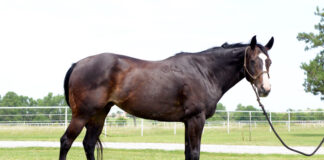Q: I have a 2-year-old mini stud with a left hind leg that locks up on him at times. If we walk him backwards, it lets go and he walks and runs fine. The vet diagnosed him with floating patella. We have never heard of it, and she also said it could be passed on to any colts. Could you please explain what floating patella is, and if it would be passed on to my horse’s foals? Can it be treated?
Luxating patellas are most commonly seen in younger horses and can be the result of weak quadriceps. This large group of muscles in the hind leg is responsible for holding the patellar ligaments tight so when these muscles are weak, the ligaments that hold the patella in place are weak as well, pre-disposing the horse to a mobile patella. Some horses only suffer from a floating patella in one hind leg, while others have bilateral, or two-sided, luxating patellas.
The most commonly recommended treatment for luxating patellas is strength conditioning with focus on the hind legs. An emphasis on hill work can help strength your horse’s quadriceps, which in turn will help keep those patellar ligaments tight. A more invasive procedure involves surgically tightening one of the patellar ligaments by nicking it to create the formation of scar tissue, which is tighter and less elastic than normal tissue. In recent decades this has fallen out of favor, but may be the only option for a horse, particularly a riding horse, that has severe laxity in those ligaments.
Unfortunately, luxating patellas are a genetic defect and these genes will be passed from your stud to his offspring. Studies have shown luxating patellas to be a recessive trait, meaning not all offspring will exhibit the clinical problem, but will still harbor the gene and therefore silently pass the trait on to their offspring.
Ask your questions on the horseillustrated.com Forums >>
See more Expert Q&As >>
Submit your Ask the Expert question >>






Good to know. I wonder if mine has it too. His back legs have a funny stiff gait. His father and brother have the same gait.